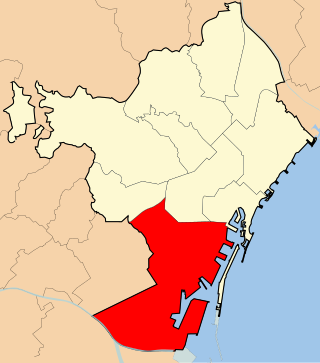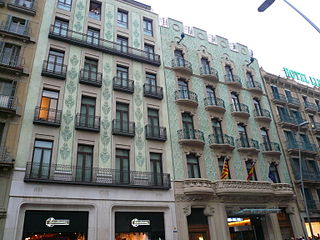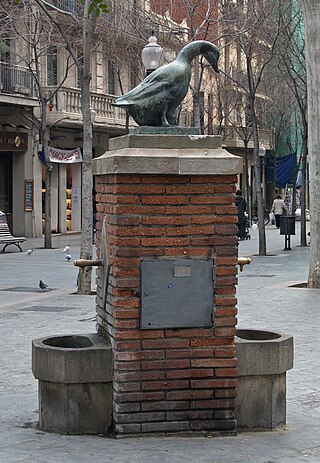
The Eixample is a district of Barcelona between the old city and what were once surrounding small towns, constructed in the 19th and early 20th centuries. Its population was 262,000 at the last census (2005).

Gràcia is a district of the city of Barcelona, Spain. It comprises the neighborhoods of Vila de Gràcia, Vallcarca i els Penitents, El Coll, La Salut and Camp d'en Grassot i Gràcia Nova. Gràcia is bordered by the districts of Eixample to the south, Sarrià-Sant Gervasi to the west and Horta-Guinardó to the east. A vibrant and diverse enclave of Catalan life, Gràcia was an independent municipality for centuries before being formally annexed by Barcelona in 1897 as a part of the city's expansion.

Gran Via de les Corts Catalanes, more simply known as Gran Via, is one of Barcelona's major avenues. With a length of 13.1 km (8.1 mi), it is the longest street in Catalonia and the 2nd longest in Spain, after Gran Vía de la Manga, in La Manga del Mar Menor, but is the one with most street numbers in Spain.

Carrer de Balmes, named after the Catalan philosopher and ecclesiastic Jaume Balmes, is one of the most important avenues in Barcelona. It was devised in 1859 as part of Ildefons Cerdà urban plan.

Sants-Montjuïc is one of the ten districts into which Barcelona has been split since 1984, numbered District 3. Comprising very different areas of the city, it covers the southern part of Barcelona, joining the two former districts II and VII, as well as the different areas comprised in the Zona Franca. As of the 2005, census it had a population of 177,636. It borders Les Corts, Eixample, Ciutat Vella, and the municipalities L'Hospitalet de Llobregat and El Prat de Llobregat.

Via LaietanaVía Layetana in Spanish, is a major thoroughfare in Barcelona, Catalonia, Spain, in the Ciutat Vella district. The avenue runs from Plaça Urquinaona to Plaça d'Antonio López, by the seafront, and separates the neighbourhoods of the old city it has on either side: La Ribera/El Born and Sant Pere on one and Barri Gòtic on the other. Besides being always overcrowded with both locals and tourists attracted by its Modernista Art Nouveau, Art Déco, and Noucentista neo-classical architecture, in addition to its nearness to the Ramblas and the quiet pedestrian streets of Barri Gòtic, Via Laietana hosts the headquarters of a number of banks and institutions.

Passeig de Sant Joan is a major avenue in the Eixample and Gràcia districts of Barcelona. It was named after an older street carrying this name, also known as Passeig Nou, built in 1795 around the glacis of the Ciutadella fortress.

The Barcelona–Vallès Line is an unconnected standard gauge rapid transit and commuter railway line linking Barcelona with Sabadell and Terrassa via the Collserola mountain range, in Catalonia, Spain. Its name refers to the Catalan historical region of Vallès, whereby most part of the line runs. Plaça de Catalunya station serves as the Barcelona terminus of the line, where almost all its trains either start or terminate. The line then continues northwards and branches off twice before leaving the city limits. Its main route splits in two in Sant Cugat del Vallès, forming two major branches to Sabadell and Terrassa. It has 40 passenger stations in operation and a total line length of 48.1 kilometres (29.9 mi).

Plaça de Francesc Macià is a square in Barcelona, Catalonia, Spain. Located in one of the main business areas of the city, it is one of the most transited points of Barcelona. It is crossed by Avinguda Diagonal and several other major thoroughfares: Avinguda de Josep Tarradellas, Travessera de Gràcia, Carrer del Comte d'Urgell and Avinguda de Pau Casals. It is part of the Sarrià-Sant Gervasi district, even though it borders two other districts of Barcelona: Les Corts and Eixample.
Avinguda de Josep Tarradellas, often known as just Avinguda Tarradellas, is an avenue in Barcelona. Most of it is in the Les Corts district of the city, while the rest acts as the border of two other districts: Sants-Montjuïc and Eixample. It starts at Plaça dels Països Catalans, by Barcelona Sants railway station, and ends at Plaça de Francesc Macià.
Carrer d'Entença is a street in Barcelona, situated in the left half of the Eixample district's grid plan. It's named after House of Entença nobleman Berenguer d'Entença i Montcada, who captained a number of expeditions towards the East in the 13th century. The naming was approved on December 19, 1863 and was already plan of Ildefons Cerdà's urban plan, even though under the tentative name of "15th street". In 1925 it was extended, reaching Avinguda Diagonal, beyond which it becomes Carrer del Doctor Fleming.

Carrer de Pelai is a major shopping street in Barcelona, one of the busiest in the city at daytime. It forms the border between the districts of Ciutat Vella and Eixample in the center of the city, and runs from the intersection of Plaça de Catalunya with La Rambla and the El Triangle shopping centre to Plaça de la Universitat. It is named after King Pelagius of Asturias. The current Catalan-language name was approved in 1980 by the city council, though it also bore that same name before 1900.

The Plaça de la Universitat is one of Barcelona's central squares, at the border between the districts of Eixample and Ciutat Vella. It is located at the intersection of Gran Via de les Corts Catalanes, Carrer d'Aribau and Ronda de Sant Antoni. It is also just west of Plaça de Catalunya, to which it is linked by the Ronda de la Universitat and Carrer de Pelai.
L'Antiga Esquerra de l'Eixample is a neighborhood in the Eixample district of Barcelona, Catalonia (Spain). Originally formed a single unit, called Esquerra de l'Eixample, with the current neighborhood la Nova Esquerra de l'Eixample. In its southern part, many bars and venues for gays can be found.

La Nova Esquerra de l'Eixample is a neighborhood in the Eixample district of Barcelona, Catalonia (Spain). Originally it formed a single unit, called Esquerra de l'Eixample, with the current neighborhood l'Antiga Esquerra de l'Eixample.

Dreta de l'Eixample is a neighborhood in the Eixample district of Barcelona, Catalonia (Spain). It is located east of Carrer de Balmes. It includes Plaça de Catalunya, the centre of the city, and the upscale streets Rambla de Catalunya and Passeig de Gràcia. It is the bourgeois neighborhood of the city, which makes the majority of its population belong to the upper class of Barcelona. Dreta de L'Eixample is one of the most luxurious neighborhoods of Barcelona.

Sant Antoni is a neighborhood in the Eixample district of Barcelona, Catalonia (Spain). Its non-official centre, the marketplace of the same name—designed by Antoni Rovira i Trias and built between 1872 and 1882—is one of the oldest and most popular in the city, especially with the secondhand book stalls that surround the building Sunday mornings. It is bordered by the neighbourhoods of the L'Antiga Esquerra de l'Eixample, the Raval, and Poble Sec. The streets of Sant Antoni follow the grid pattern prevalent in all of Eixample, except for a central thoroughfare, the Avinguda de Mistral, built on the site of an important medieval road which led out of Barcelona. Another well-known landmark of Sant Antoni is the bar called Els Tres Tombs, right next to the market.

El Camp de l'Arpa del Clot is one of the ten neighborhoods of Barcelona which compose the district of Sant Martí, Catalonia (Spain). It was annexed by Barcelona in the year 1897. It is situated in the upper part of this district and before it was named Camp de l'Arca.

Carrer del Consell de Cent is a long avenue in Barcelona, Catalonia, Spain. It is one of the horizontal streets of the urban grid that makes up Eixample district, spanning the Esquerra de l'Eixample and the Dreta de l'Eixample quarters, starting at the Parc de Joan Miró by carrer de Vilamarí and ending in the neighbourhood of El Clot, by Avinguda Meridiana, in the Sant Martí district.

Plaça de Tetuan, known in Spanish as Plaza de Tetuán, is a major square in Barcelona. It is in Fort Pienc, in the central district of Eixample, at the busy intersection of Gran Via de les Corts Catalanes and Passeig de Sant Joan. The square is named after the 1860 Battle of Tétouan, the siege and occupation of the Moroccan city of Tetuan by general Joan Prim and Catalan volunteers. It was formerly called Hermenegildo Giner de los Ríos.
















